FIBC Dischargers: Streamlining Bulk Material Handling
FIBC dischargers can be tailored to meet specific needs of various industries, making them an indispensable tool for modern bulk material handling operations.
September 29, 2023
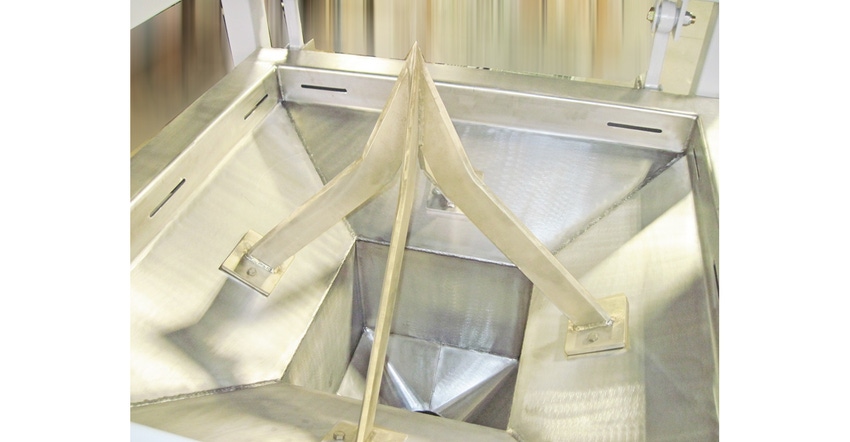
Tom Picone, director of business development, Vibra Screw Inc.
Flexible Intermediate Bulk Containers (FIBCs), commonly known as bulk bags or super sacks, are widely used in many industries for the storage and transportation of granular or powdered materials. FIBCs are cost-effective, space-efficient, and easy to handle, making them an ideal choice for bulk material handling.
FIBCs come in a range of sizes, capacities, and features that affect the ability of powdered material to flow continuously from the bag. The type of bag and its features directly affect the design of the bulk bag unloader and its ability to discharge the material on demand. S
These are some key bag features that affect material flow from bags:
Flow Rate/Material Type: The type of material used for the sack construction can influence the flow rate of bulk materials stored inside. For example, bags made of woven polypropylene (PP) or polyester tend to have good flow characteristics for many dry bulk materials due to their smooth surfaces.
Coating or Treatment/Coated or Treated Fabrics: Some super sacks are coated with special materials or treated to enhance their flow characteristics. This can include anti-slip coatings or treatments to reduce friction and improve the flow of materials.
Liners/Liner Material): Some super sacks come with liners, which can be made of materials like polyethylene. Liners can help improve the flow of materials and prevent moisture ingress or contamination.
Moisture Resistance/Moisture Barrier: Some materials are better at resisting moisture penetration, which is crucial when storing hygroscopic materials or when the super sacks are exposed to humid conditions.
UV Resistance: For outdoor storage and transportation, UV-resistant materials may be used to prevent degradation of the super sack's fabric, which could affect its flow properties over time.
Chemical Compatibility/Material Compatibility: The choice of materials should consider the compatibility of the super sack with the stored bulk material. Some chemicals can react with or degrade certain bag materials, affecting their flow characteristics.
Electrostatic Properties/Anti-static Materials: Some materials used in super sacks are designed to dissipate or prevent the build-up of static electricity. This can be crucial when handling combustible materials or powders prone to static discharge.
To ensure efficient and convenient material discharge from FIBCs, FIBC dischargers, also known as bag dump stations or bulk bag unloaders, are employed. In this article, we will explore the key features, working principles, and benefits of FIBC dischargers.
Overview of FIBC Dischargers
FIBC dischargers are specialized equipment designed to facilitate the efficient and controlled discharge of bulk materials from FIBCs. They eliminate the need for manual handling, reduce labor costs, reduce shipping cost, (over paper sacks and in many cases can be reused) and improve overall operational efficiency. FIBC dischargers typically consist of a support structure, bag lifting mechanism, dust containment system, material discharge mechanism, and control system.
Working Principles of FIBC Dischargers
The working principles of FIBC dischargers involve a series of steps to ensure the controlled and safe discharge of materials. The process typically includes the following stages:
a. Bag Handling: The FIBC is manually or mechanically placed onto the discharger, secured, and lifted to an appropriate height using a bag lifting mechanism. This mechanism can be either hoist and trolley (integral to the bag unloader frame or located separately on the user’s factory located I beam) or a forklift-based system.
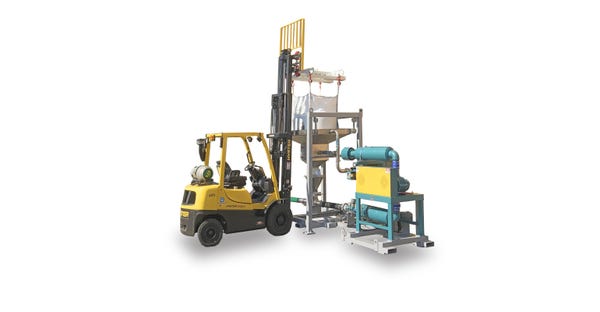
b. Dust Containment: FIBC dischargers are equipped with dust containment systems to minimize the release of dust during the discharge process. These systems often include dust collection hoods, integrated dust collectors, connection points for external dust collection systems or completely enclosed support frame.
c. Material Discharge: Once the FIBC is properly positioned and secured on the unloader, the material discharge mechanism is activated. This can involve various methods, such as simple gravitational flow, controlled vibration, or mechanical agitation. The method of agitation chosen is dependent on the handling characteristics of the material being discharged.
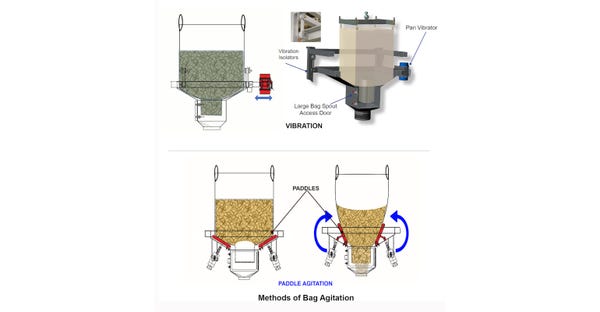
d. Material Conveyance: After the material is discharged from the FIBC, it is conveyed to the downstream process or storage system using conveyors, pneumatic systems, or other suitable means.
Key Features and Options
FIBC dischargers come with many key features and options to accommodate different material characteristics, process requirements, and industry standards. Some of the notable features and options include:
a. Bag Spout Access: FIBC dischargers may have access chambers or glove box bottom access points for bag spouts. This allows the operator a safe and dust tight means to un-tie and retie the bag spout in a safe manner.
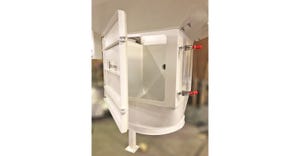
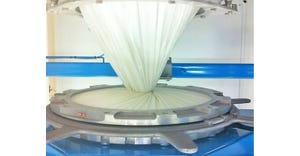
b. Bag Without Spouts (or one-way bags): For those bags that are not designed with discharge spouts the FIBC unloader can be equipped with bag slicers or bag cutters. When the weight of the bag is placed on the unloader slicer, the bag bottom is cut into sections forming an opening allowing the contents inside the bulk bag to flow out, gravitating into the discharge hopper or onto the feeding device below.


c. Bag Discharge Flow Control: Various flow control mechanisms can be employed, such as gravity flow chutes, rotary valves, screw feeders, or vibratory feeders, depending on the material's flow properties and the desired discharge rate.
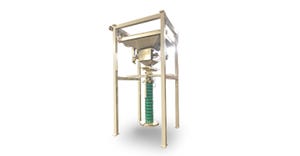
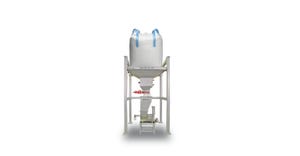
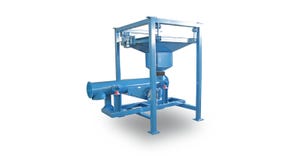
d. Dust Containment Systems: Effective dust containment systems may include integrated dust collection connections for use with external central dust collector or bag unloader frame supported dust collector which can feed the dust back into the system to ensure a safe and clean working environment.
e. Material Conditioning: FIBC dischargers can incorporate material conditioning devices, such as agitators or vibrators, to assist in the discharge of cohesive or compacted materials.
f. Weighing and Batching: Some FIBC dischargers are equipped with weighing systems to accurately measure the discharged material's weight and enable precise batching.
g. Material Contact Surfaces: FIBC dischargers can be constructed from different materials, such as stainless steel or carbon steel, depending on the material's corrosiveness and hygiene requirements.
Benefits of FIBC Dischargers
Employing FIBC dischargers in bulk material handling operations provides numerous benefits:
a. Increased Efficiency: FIBC dischargers streamline the material discharge process, reducing manual handling and labor costs, and improving overall operational efficiency.
b. Dust Containment: The integration of dust containment systems minimizes dust emissions, enhancing workplace safety and meeting environmental regulations.
c. Material Preservation: By controlling the material discharge rate and minimizing exposure to the surrounding environment, FIBC dischargers help preserve the quality and integrity of the bulk materials.
d. Versatility: FIBC dischargers are highly adaptable to different material types, including powders, granules, flakes, and pellets, making them suitable for a wide range of industries such as food, pharmaceuticals, chemicals, and construction.
e. Hygienic Design: FIBC dischargers can be designed to meet strict sanitary standards, ensuring compliance with food safety and pharmaceutical regulations.
f. Customization Options: Manufacturers offer customization options to tailor FIBC dischargers to specific process requirements, including discharge rates, material conditioning, weighing systems, and integration with downstream equipment.
Conclusion
FIBC dischargers play a crucial role in streamlining bulk material handling processes. Their efficient and controlled discharge mechanisms, coupled with dust containment systems, offer significant advantages in terms of operational efficiency, workplace safety, and material preservation. With a wide range of features and customization options available, FIBC dischargers can be tailored to meet the specific needs of various industries, making them an indispensable tool for modern bulk material handling operations.
Tom Picone is director of business development at Vibra Screw Inc. (Totowa, NJ), a manufacturer of material handling equipment, including, loss-in-weight feeders, weigh belts screw feeders and bin dischargers. For more information, email to [email protected], or visit www.vibrascrew.com.
You May Also Like


